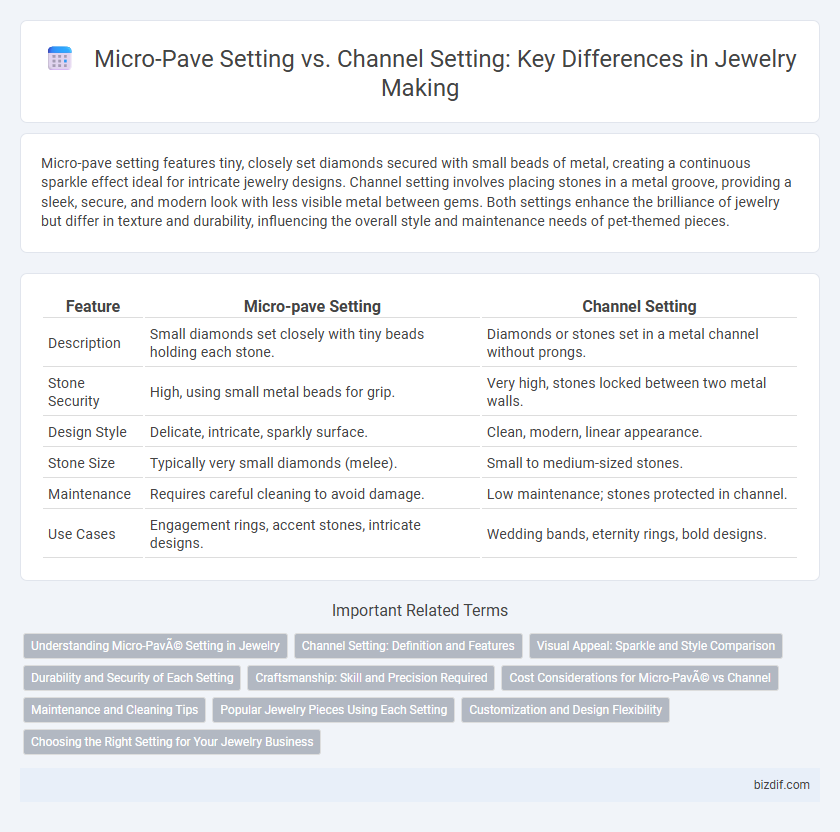Micro-pave setting features tiny, closely set diamonds secured with small beads of metal, creating a continuous sparkle effect ideal for intricate jewelry designs. Channel setting involves placing stones in a metal groove, providing a sleek, secure, and modern look with less visible metal between gems. Both settings enhance the brilliance of jewelry but differ in texture and durability, influencing the overall style and maintenance needs of pet-themed pieces.
Table of Comparison
| Feature | Micro-pave Setting | Channel Setting |
|---|---|---|
| Description | Small diamonds set closely with tiny beads holding each stone. | Diamonds or stones set in a metal channel without prongs. |
| Stone Security | High, using small metal beads for grip. | Very high, stones locked between two metal walls. |
| Design Style | Delicate, intricate, sparkly surface. | Clean, modern, linear appearance. |
| Stone Size | Typically very small diamonds (melee). | Small to medium-sized stones. |
| Maintenance | Requires careful cleaning to avoid damage. | Low maintenance; stones protected in channel. |
| Use Cases | Engagement rings, accent stones, intricate designs. | Wedding bands, eternity rings, bold designs. |
Understanding Micro-Pavé Setting in Jewelry
Micro-pave setting in jewelry involves placing tiny diamonds closely together with minimal metal visibility, creating a continuous sparkle effect on the surface. This technique requires precision drilling of small holes into the metal to securely hold each stone with fine prongs or beads. Compared to channel setting, which arranges stones in a linear groove secured by metal walls, micro-pave offers a more delicate, intricate texture ideal for accentuating detailed designs.
Channel Setting: Definition and Features
Channel setting is a jewelry technique where gemstones are strung closely together in a metal channel, creating a smooth and continuous row without prongs. This setting provides excellent protection for the stones, making it ideal for rings and bracelets subjected to daily wear. The channel setting enhances the brilliance of diamonds or gemstones by allowing light to enter from the top, while maintaining a sleek, modern look with secure positioning.
Visual Appeal: Sparkle and Style Comparison
Micro-pave setting features numerous tiny diamonds set closely together, creating a continuous sparkling surface that maximizes light reflection and brilliance. Channel setting houses larger diamonds in a sleek groove, offering a streamlined look with enhanced durability and a modern silhouette. The micro-pave setting excels in dazzling sparkle and intricate detail, while the channel setting provides a bold, clean style with pronounced gemstone visibility.
Durability and Security of Each Setting
Micro-pave setting offers exceptional security with tiny prongs that tightly grip each gemstone, minimizing the risk of stones loosening or falling out, ideal for intricate designs requiring durability. Channel setting features a durable metal groove that securely holds stones edge-to-edge without prongs, providing enhanced protection against impact and making it especially suitable for pieces exposed to frequent wear. Both settings prioritize stone stability, but channel setting typically ensures greater overall durability and resistance to damage due to its continuous metal framework.
Craftsmanship: Skill and Precision Required
Micro-pave setting demands exceptional craftsmanship, requiring jewelers to meticulously place tiny diamonds close together with precision tools to create a continuous sparkle. Channel setting involves embedding stones into a metal groove, necessitating steady hands and accuracy to ensure uniform alignment and secure placement. Both techniques showcase skilled artistry, but micro-pave setting typically requires finer attention to detail due to the smaller stones and delicate spacing.
Cost Considerations for Micro-Pavé vs Channel
Micro-pave setting often incurs higher costs due to the intricate placement of numerous small stones requiring skilled craftsmanship and longer labor time. Channel setting generally offers a more cost-effective solution as it involves setting fewer stones in a continuous groove, reducing complexity and production time. Material waste and risk of stone loss also influence pricing, with micro-pave demanding more precision and consequently higher expenses.
Maintenance and Cleaning Tips
Micro-pave settings require delicate cleaning with a soft brush and mild detergent to avoid dislodging tiny stones, while ultrasonic cleaners are generally not recommended. Channel settings, with their securely set stones, are easier to clean using ultrasonic cleaners and gentle polishing cloths. Regular inspection is essential for both settings to ensure stones remain secure and settings intact.
Popular Jewelry Pieces Using Each Setting
Micro-pave setting is commonly used in engagement rings and delicate bracelets, enhancing sparkle with tiny diamonds tightly set in intricate patterns. Channel setting is favored in wedding bands and tennis bracelets, where gemstones sit securely between metal walls for a sleek, uninterrupted row of stones. Both settings optimize durability and design, with micro-pave highlighting brilliance and channel setting providing a smooth, modern aesthetic.
Customization and Design Flexibility
Micro-pave setting offers exceptional design flexibility by allowing intricate patterns with numerous tiny diamonds closely set for maximum sparkle, ideal for highly detailed, custom jewelry pieces. Channel setting provides a sleek, continuous row of gemstones held securely between metal walls, offering a clean and modern look but with more limited customization options. Jewelers often choose micro-pave for personalized, elaborate designs, while channel setting suits minimalist styles with emphasis on durability and uniformity.
Choosing the Right Setting for Your Jewelry Business
Selecting the right setting for your jewelry business depends on the design's aesthetic and durability requirements. Micro-pave setting offers intricate sparkle by setting tiny diamonds closely together with minimal metal visibility, ideal for delicate and high-end pieces. Channel setting provides a secure and sleek design by embedding stones between metal channels, perfect for wedding bands and jewelry requiring robust stone protection.
Micro-pavé setting vs channel setting Infographic

 bizdif.com
bizdif.com